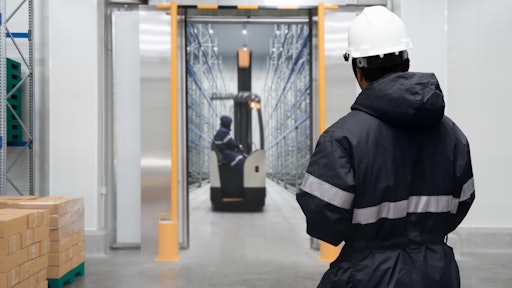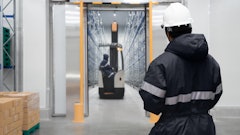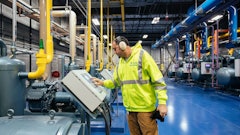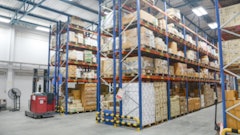
Safety is at the heart of every process in the cold storage industry, yet a series of issues continue to haunt leaders and potentially hinder operations. By creating an internal “safety culture,” cold storage companies can more seamlessly uphold the health and well-being of team members, work environments, local communities and food products while also protecting the brand reputation of our customers.
Warehouse team members can face a number of safety challenges daily. Repetitive motion injuries from high-volume case picking, risks associated with operating material handling equipment and the potential of ammonia exposure are some of the risks needed to mitigate in day-to-day operations.
To ensure the well-being of employees, customer brand reputation, company assets and operating environments, companies need a true “safety culture.” Simply put, this is a collection of beliefs, perceptions and values within an organization established to reduce internal risk.
In a safety culture, safety is recognized, embraced and prioritized throughout all levels of the organization — from the CEO all the way onto the warehouse floor. And to be effective, a safety culture has to be a part of the company’s DNA and embedded in everything each team member does daily.
Here is a breakdown of how to create a safety culture foundation:
Develop a committee tasked with driving safety culture and expectations. These team members are charged with promoting the company’s safety and compliance programs and initiatives, listening to associates, and continuously looking for improvement opportunities.
Adopt near-miss reporting processes. Incident reporting enables companies to develop solutions to potential problems before they even occur. By sharing results between facilities, leaders can collaborate on best practices, ensuring that proven safety processes or technology solutions are quickly distributed company wide.
Create comprehensive safety onboarding programs. Integrating safety overviews into new employee training must be a priority. Training should delve into potential risks and hazards across each job function, as well as the ideal processes required to keep employees, product and workspaces safe. Employee orientations should range from high-level overviews down to specific multi-day deep dives, as well as offering relevant certifications if appropriate for the role.
Safety training should also be ongoing throughout team members’ careers, and learning modules should be refreshed regularly. As the risks and hazards of particular job functions or the working environment change, risks assessments should be conducted, programs and policies updated and training should be completed.
Cold storage companies also need to recognize individuals and facilities that have achieved their safety-related goals or reached significant milestones to reinforce the culture of safety in a positive way.
Top concerns
As the industry evolves, so do potential dangers. With an underlying safety culture, companies are better equipped to tackle the industry’s most concerning safety issues, including:
Challenge: Repetitive motion injuries
Repetitive motion injuries, or repetitive strain injuries (RSIs), are a growing concern in warehouse settings. These injuries result from the repetition of specific movements, overuse of certain muscles, as well as inadequate rest periods.
Solution:
To prevent these injuries, operators should explore how to integrate ergonomics across processes to ensure that workers can maintain comfortable and natural body positions. It is also important to provide warehouse workers with comprehensive training on proper lifting techniques, body mechanics and other safe work practices. Employees should also be encouraged to report any discomfort or pain immediately. Consider team members who perform these physically demanding tasks as “industrial athletes” and look for solutions to mitigate the challenges of their role.
Warehouses are encouraged to enforce job rotation which enables employees to switch between different tasks periodically, and encourage regular stretching exercises before, during and after shifts to improve flexibility. Finally, it is imperative to institute standardized rest breaks and workplace assessments to proactively identify potential risks and make necessary adjustments to improve safety.
Challenge: Material handling equipment dangers
Despite an increase in automation across warehouse operations, facilities still have to rely on material handling equipment such as forklifts and pallet jacks as part of their operations. Among the hazards warehouse operators could be subject to without a proper safety culture include falling materials and collapsing loads; using improper lifting techniques to move materials that exceed load limits; and being caught in moving pieces of equipment.
Solution:
Implementing proper safety measures to ensure equipment is being used accurately is crucial in preventing accidents and injuries and damaging goods. Companies should institute employee training programs and distinct safety procedures for all warehouse and materials handling processes. This includes guidelines for equipment operation, loading and unloading goods, emergency procedures and proper use of personal protective equipment (PPE).
Other considerations to reduce risk of accidents include keeping warehouses organized and free from clutter; installing clear and visible signs throughout the warehouse to indicate potential hazards, safety instructions and emergency exits, and adhering to load capacity limits for all equipment. Every facility should also conduct regular safety inspections and audits.
Challenge: Potential ammonia releases
Ammonia is an efficient refrigerant used in the cold storage industry, as well as many other refrigeration and air-conditioning processes. Ammonia-based refrigeration systems enable cold supply companies to reduce both energy use and costs. Despite these benefits, there could be significant risks if these systems are not managed properly, including routine inspections, proactive maintenance and having a well-defined process safety management (PSM) program. Exposure to high concentrations of ammonia could be fatal and, under certain conditions, could be explosive if released.
Solution:
To mitigate these risks, operators must take preventive measures and have proper safety protocols in place.
In addition to the aforementioned training, audits and PPE, companies should periodically conduct comprehensive risk assessments to identify potential sources of ammonia leaks, conduct routine drills and have a detailed emergency response plan specifically tailored to handle ammonia releases. Warehouses also need to install updated ammonia leak detection systems with alarms that can alert workers and trigger automatic shut-off valves or ventilation systems. Prohibiting unauthorized access to ammonia storage areas is also crucial to reducing the risk of tampering.
Third-party collaboration
As the saying goes, “it takes a village” to achieve success, and that includes collaborating with third-party partners and innovations revolving around safety.
Creating a must-have safety culture in the cold storage industry requires a combination of attitudes, values and actions that positively influence processes. By implementing a dedicated task force, reporting incidents, implementing solutions and proper safety measures, cold facilities will create a safer, more efficient workplace for everyone.

























